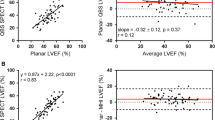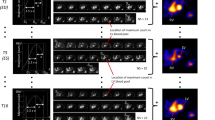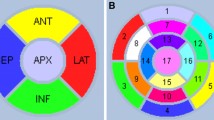Abstract
The purpose of this study was to address the issue of 180° versus 360° data collection for left ventricular ejection fraction (LVEF) and left ventricular volume measurements using gated myocardial perfusion tomography (gMPT) and gated blood pool tomography (gBPT). Thirty patients with known coronary artery disease were injected in a random sequence with 925 MBq of technetium-99m tetrofosmin and, within 2 days, with 740 MBq of 99mTc-labelled human serum albumin. gMPT and gBPT were acquired using 360° data collection and reconstructed by filtered backprojection using all the acquired projection images and separately using only projection images acquired from 45° LPO to 45° RAO. In order to have the same global count densities, the counts in the 360° data set were redistributed using binomial deviates just before reconstruction. After reorientation along the left ventricular long axis, LVEF and left ventricular volumes were calculated using fully automatic algorithms. Twenty-eight patients also underwent planar radionuclide angiocardiography (PRNA) on the same day as the gBPT. For the gMPT studies, the correlation between 180° data collection and 360° data collection was excellent (r>0.98). Bland-Altman analysis revealed small systematic and random differences (<6%) between 180° and 360°. For the gBPT studies, the correlation between 180° data collection and 360° data collection was very good (r>0.93). However, Bland-Altman analysis revealed systematic differences of 26% and random differences of 17%. When PRNA was used as a reference, the best results were obtained with gMPT acquired using 180° data, while the worst results were obtained with gBPT acquired using 180° data. In conclusion, when evaluating LVEF and left ventricular volumes from gMPT, either 180° or 360° orbits can be used. However, 360° data acquisition is recommended when evaluating LVEF and left ventricular volumes from gBPT.


Similar content being viewed by others
References
Coleman RE, Jaszczak RJ, Cobb FR. Comparison of 180° and 360° data collection in thallium-201 imaging using single-photon emission computerized tomography (SPECT): concise communication. J Nucl Med 1982; 23:655–660.
Knesaurek K, King MA, Glick SJ, Penny BC. Investigation of causes of geometric distortion in 180° and 360° angular sampling in SPECT. J Nucl Med 1989; 30:1666–1675.
Hoffman EJ. 180° compared with 360° sampling in SPECT. J Nucl Med 1982; 23:745–747.
Liu YH, Lam PT, Sinusas AJ, Wackers FJ. Differential effect of 180° and 360° acquisition orbits on the accuracy of SPECT imaging: quantitative evaluation in phantoms. J Nucl Med 2002; 43:1115–1124.
Tamaki N, Mukai T, Ishii Y, Fujita T, Yamamoto K, Minato K, Yonekura Y, Tamaki S, Kambara H, Kawai C, Torizuka K. Comparative study of thallium emission myocardium tomography with 180° and 360° data collection. J Nucl Med 1982; 23:661–666.
Freeman MR, Konstantinou C, Barr A, Greysin NC. Clinical comparison of 180° and 360° data collection of technetium 99m sestamibi SPECT for detection of coronary artery disease. J Nucl Cardiol 1998; 5:14–18.
Eisner RL, Nowak DJ, Pettigrew R, et al. Fundamentals of 180 degree acquisition and reconstruction in SPECT imaging. J Nucl Med 1986; 27:1717–1728.
Maublant JC, Peycelon P, Kwiatkowski F, et al. Comparison between 180 degree and 360 degree data collection in technetium-99m MIBI SPECT of the myocardium. J Nucl Med 1989; 30:295–300.
DePuey EG, Garcia EV. Updated imaging guidelines for nuclear cardiology procedures. J Nucl Cardiol 2001; 8:G1–G58.
Snyder D, Miller M. Random point processes in time and space, 2nd edn. New York: Springer, 1991.
Press WH, Teukolsky SA, Vetterling WT, Flannery BP. Numerical recipes in C. Cambridge: Cambridge University Press, 1992.
Devroye L. Non-uniform random variate generation. New York: Springer, 1986.
Germano G, Kiat H, Kavanagh PB, et al. Automatic quantification of ejection fraction from gated myocardial perfusion SPECT. J Nucl Med 1995; 36:2138–2147.
Vanhove C, Franken PR, Defrise M, Momen A, Everaert H, Bossuyt A. Automatic determination of left ventricular ejection fraction from gated blood pool tomography. J Nucl Med 2001; 42:401–407.
Vanhove C, Franken PR. Left ventricular ejection fraction and volumes from gated blood pool tomography: comparison between two automatic algorithms working in three-dimensional space. J Nucl Cardiol 2001; 8:466–471.
Vanhove C, Walgraeve N, De Geeter F, Franken PR. Gated myocardial perfusion tomography versus gated blood pool tomography to calculate left ventricular volumes and ejection fraction. Eur J Nucl Med 2002; 29:735–741.
Bland JM, Altman DG. Statistical methods for assessing agreement between two methods of clinical measurements. Lancet 1986; 1:307–310.
Kubo N, Mabuchi M, Katoh C, et al. Accuracy and reproducibility of left ventricular function from quantitative, gated, single photon emission computed tomography using dynamic myocardial phantoms: effect of pre-reconstruction filters. Nucl Med Commun 2002; 23:529–536.
Nakajima K, Taki J, Higuchi T, et al. Gated SPET quantification of small hearts: mathematical simulation and clinical application. Eur J Nucl Med 2000; 27:1372–1379.
Achert A, King MA, Dahlberg ST, et al. An investigation of the estimation of ejection fractions and cardiac volumes by a quantitative gated SPECT software package on simulated gated SPECT images. J Nucl Cardiol 1998; 5:144–152.
Nakajima K, Higuchi T, Taki J, Kawano M, Tonami N. Accuracy of ventricular volume and ejection fraction measured by gated myocardial SPECT: comparison of 4 software programs. J Nucl Med 2001; 42:1571–1578.
Author information
Authors and Affiliations
Corresponding author
Rights and permissions
About this article
Cite this article
Vanhove, C., Franken, P.R., Defrise, M. et al. Comparison of 180° and 360° data acquisition for determination of left ventricular function from gated myocardial perfusion tomography and gated blood pool tomography. Eur J Nucl Med Mol Imaging 30, 1498–1504 (2003). https://doi.org/10.1007/s00259-003-1267-1
Received:
Accepted:
Published:
Issue Date:
DOI: https://doi.org/10.1007/s00259-003-1267-1




